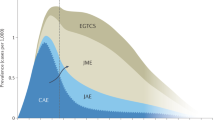Abstract
Purpose
We compared the demographic, clinical, and electroencephalographic (EEG) characteristics between females and males with idiopathic generalized epilepsy (IGE).
Methods
In this retrospective study, all patients with a clinical diagnosis of IGE were recruited at the outpatient epilepsy clinic at Shiraz University of Medical Sciences, from 2008 through 2019. Age, gender, age at seizure onset, seizure type(s), epilepsy risk factors, and EEG findings of all patients were registered routinely.
Results
Six hundred one patients with IGE were studied: 361 patients (60%) were females, and 240 people (40%) were males. The mean age at onset of seizures was 1.3 years earlier in males compared with that in females. Myoclonic seizures were more frequently reported by females than that by males. Photoparoxysmal response during intermittent photic stimulation in the EEG laboratory was more often observed in females than that in males. The difference in the syndromic diagnosis between the sexes was significant (p = 0.02). Among male patients, 88% were on valproate, and among female patients, 49% were on valproate (p = 0.0001). At the last follow-up visit, 83 males (61%) and 108 females (49%) were seizure-free (p = 0.02).
Conclusion
There are significant demographic, clinical, and electrographic differences between females and males with IGEs. The reasons behind these sex differences among patients with IGE are not clear. However, it is likely that sex hormones and sex chromosome genes-related brain differences play a role in the development of these differences. These interesting findings and the proposed hypothesis should be explored in future studies.
Similar content being viewed by others
Data availability
Research data are not shared.
References
Blume WT, Lüders HO, Mizrahi E et al (2001) Glossary of descriptive terminology for ictal semiology: report of the ILAE task force on classification and terminology. Epilepsia 42:1212–1218
Asadi-Pooya AA, Emami M, Sperling MR (2013) A clinical study of syndromes of idiopathic (genetic) generalized epilepsy. J Neurol Sci 324:113–117
Engel JJ (2001) A proposed diagnostic scheme for people with epileptic seizures and epilepsy: report of the ILAE task force on classification and terminology. Epilepsia 42:796–803
Nordli DR (2005) Idiopathic generalized epilepsies recognized by the International League Against Epilepsy. Epilepsia 46:48–56
Panayiotopoulos CP (2005) Syndromes of idiopathic generalized epilepsies not recognized by the International League Against Epilepsy. Epilepsia 46:57–66
Asadi-Pooya AA, Homayoun M (2020) Idiopathic (genetic) generalized epilepsies with absences: clinical and electrographic characteristics and seizure outcome. Neurol Sci. https://doi.org/10.1007/s10072-020-04490-7
Loke H, Harley V, Lee J (2015) Biological factors underlying sex differences in neurological disorders. Int J Biochem Cell Biol 65:139–150
Christensen J, Kjeldsen MJ, Andersen H, Friis ML, Sidenius P (2005) Gender differences in epilepsy. Epilepsia 46:956–960
Mullins GM, O'sullivan SS, Neligan A et al (2007) A study of idiopathic generalised epilepsy in an Irish population. Seizure 16:204–210
van Luijtelaar G, Onat FY, Gallagher MJ (2014) Animal models of absence epilepsies: what do they model and do sex and sex hormones matter? Neurobiol Dis 72 Pt B:167–179
Pal DK, Durner M, Klotz I, Dicker E, Shinnar S, Resor S, Cohen J, Harden C, Moshé SL, Ballaban-Gill K, Bromfield EB, Greenberg DA (2006) Complex inheritance and parent-of-origin effect in juvenile myoclonic epilepsy. Brain and Development 28:92–98
Martins da Silva A, Leal B (2017) Photosensitivity and epilepsy: current concepts and perspectives-a narrative review. Seizure 50:209–218
Tomson T, Marson A, Boon P, Canevini MP, Covanis A, Gaily E, Kälviäinen R, Trinka E (2015) Valproate in the treatment of epilepsy in girls and women of childbearing potential. Epilepsia 56:1006–1019
Giri VP, Giri OP, Khan FA, Kumar N, Kumar A, Haque A (2016) Valproic acid versus lamotrigine as first-line monotherapy in newly diagnosed idiopathic generalized tonic -clonic seizures in adults - a randomized controlled trial. J Clin Diagn Res 10:FC01–FC04
Marson AG, Al-Kharusi AM, Alwaidh M et al (2007) The SANAD study of effectiveness of valproate, lamotrigine, or topiramate for generalised and unclassifiable epilepsy: an unblinded randomised controlled trial. Lancet 369:1016–1026
Asadi-Pooya AA, Homayoun M (2020) Tonic-clonic seizures in idiopathic generalized epilepsies: prevalence, risk factors, and outcome. Acta Neurol Scand 141:445–449
Acknowledgments
We thank the Neuroscience Research Center, Shiraz University of Medical Sciences, for supporting this study.
Funding
Shiraz University of Medical Sciences funded this study.
Author information
Authors and Affiliations
Contributions
Ali A. Asadi-Pooya, M.D.: Study design, data collection, statistical analysis, manuscript preparation. Maryam Homayoun, M.D.: Data collection, manuscript preparation
Corresponding author
Ethics declarations
Conflict of interest
Ali A. Asadi-Pooya, M.D.: Honoraria from Cobel Daruo, RaymanRad, and Tekaje; Royalty: Oxford University Press (Book publication). Maryam Homayoun, M.D.
Ethical approval
This study was conducted with the approval by Shiraz University of Medical Sciences Institutional Review Board.
Additional information
Publisher’s note
Springer Nature remains neutral with regard to jurisdictional claims in published maps and institutional affiliations.
Rights and permissions
About this article
Cite this article
Asadi-Pooya, A.A., Homayoun, M. Sex differences in characteristics of idiopathic generalized epilepsies. Neurol Sci 42, 2421–2424 (2021). https://doi.org/10.1007/s10072-020-04834-3
Received:
Accepted:
Published:
Issue Date:
DOI: https://doi.org/10.1007/s10072-020-04834-3




